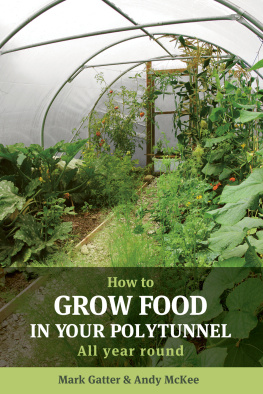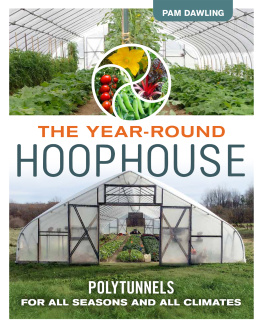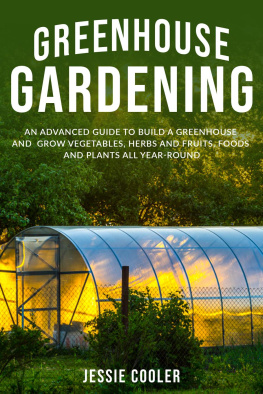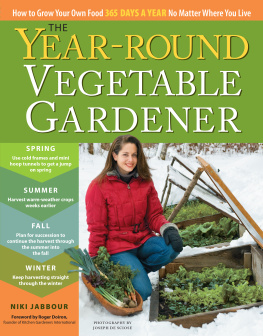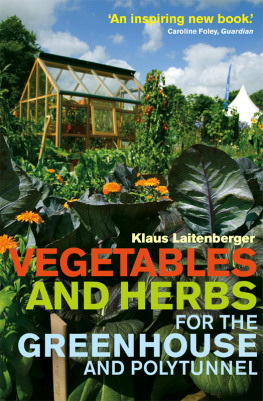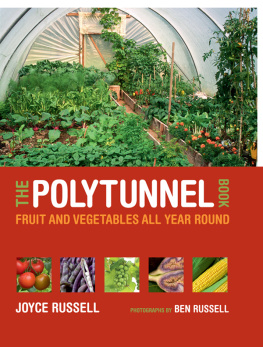Mark Gatter - How to grow food in your polytunnel : all year round
Here you can read online Mark Gatter - How to grow food in your polytunnel : all year round full text of the book (entire story) in english for free. Download pdf and epub, get meaning, cover and reviews about this ebook. City: Totnes, Devon England, year: 2010, publisher: Green Books, genre: Home and family. Description of the work, (preface) as well as reviews are available. Best literature library LitArk.com created for fans of good reading and offers a wide selection of genres:
Romance novel
Science fiction
Adventure
Detective
Science
History
Home and family
Prose
Art
Politics
Computer
Non-fiction
Religion
Business
Children
Humor
Choose a favorite category and find really read worthwhile books. Enjoy immersion in the world of imagination, feel the emotions of the characters or learn something new for yourself, make an fascinating discovery.
- Book:How to grow food in your polytunnel : all year round
- Author:
- Publisher:Green Books
- Genre:
- Year:2010
- City:Totnes, Devon England
- Rating:3 / 5
- Favourites:Add to favourites
- Your mark:
- 60
- 1
- 2
- 3
- 4
- 5
How to grow food in your polytunnel : all year round: summary, description and annotation
We offer to read an annotation, description, summary or preface (depends on what the author of the book "How to grow food in your polytunnel : all year round" wrote himself). If you haven't found the necessary information about the book — write in the comments, we will try to find it.
Mark Gatter: author's other books
Who wrote How to grow food in your polytunnel : all year round? Find out the surname, the name of the author of the book and a list of all author's works by series.
How to grow food in your polytunnel : all year round — read online for free the complete book (whole text) full work
Below is the text of the book, divided by pages. System saving the place of the last page read, allows you to conveniently read the book "How to grow food in your polytunnel : all year round" online for free, without having to search again every time where you left off. Put a bookmark, and you can go to the page where you finished reading at any time.
Font size:
Interval:
Bookmark:
How to Grow Food
in Your Polytunnel
All year round
First published in 2010 by
Green Books
Foxhole, Dartington,
Totnes, Devon TQ9 6EB
www.greenbooks.co.uk
Mark Gatter and Andy McKee
Design by Stephen Prior
All rights reserved. No part of this book may be transmittedor reproduced in any form or by any means without permission in writing from the publisher.
All pictures are by Mark Gatter and Andy McKee, unless otherwise credited.
DISCLAIMER: The advice herein is believed to be correct at the time of printing, but the authors and publishers accept no liability for actions inspired by this book.
Print edition ISBN 978 1 900322 72 0
PDF format ISBN 978 0 85784 008 0
ePub format ISBN 978 0 85784 009 7
Dedications
To Andys beautiful wife Toni, who suffered the most horrendous bout of flu during the preparation of this book, and never complained once that he was ignoring her.
To Marks serene and unruffled wife Linda, who is a much better person than hell ever be. And far better organised.
To Frances Kelly, our agent, for making all this possible.
To Amanda Cuthbert, Alethea Doran and all the staff at Green Books, for being so supportive.
Acknowledgements
The authors would like to thank Sean Barker of First Tunnels, Rebecca Hillman, Richard Thornbury, Moira Thomson and Shelley Watson, for their contributions and help.
A polytunnel is perhaps the most underrated tool in the modern kitchen garden. Being able to create a warm, sheltered microclimate confers huge advantages, because using anything from a few bottle cloches to a glass greenhouse allows us to grow tender plants in conditions they would never cope with otherwise. This doesnt just widen the range of crops you can grow; it also increases their yield, vigour and harvesting period. Polytunnels are an extension of the same idea but on a much larger scale, which has some dramatic benefits.
Andy says:
Were not just talking about the plants, either. The label growing under cover doesnt tell you anything about just how nice I find it to step into my own polytunnel. Warm, bright and spacious, with a handy hook for my soggy raincoat, theres simply no better place for a gardener to be on a blustery, wet day in April. With not a slug in sight, the staging is busy with modules full of tiny plants in tip-top condition and the soil beds are already filling up. With my sowing plan hanging from a little hook on a suspended shelf, everything I need is right to hand except the kettle. Now theres a thought
In this book we give you the tools you need to make the most out of every precious inch of covered space throughout the whole year. , Dealing with pests and diseases, should help when dealing with some common tunnel nasties. The tips boxes scattered throughout the book contain a collection of our favourite tunnel growing strategies, but no doubt you will find many more as your own growing experiments bear fruit. Finally, we have included charts to help you use your tunnel in tandem with your outdoor plot and a Resources section for further information and suppliers.
The technical aspects of polytunnel use, such as planning, buying, erecting and maintaining tunnels, are detailed in our previous book, The Polytunnel Handbook (see Resources section).
Mark says:
Imagine gardening in a thin T-shirt in the middle of winter and, of course, to do so outside would be to invite hypothermia anywhere close to where I live. However, its not unusual to find me dressed like that in the polytunnel, even in January, thinning the carrots or picking the evenings salad. Aside from a polytunnel being an amazing extension to a vegetable garden, the benefit of a warm, calm and bright spot to sit in in a garden is a wonderful thing to have when the rest of the world seems cold, damp and grey.
Many people think of polytunnels as a type of cheap greenhouse, but there are some important differences, such as the fact that polytunnels need more attention to ventilation and tend to have higher humidity than their rigid cousins. The main difference, however, is one of scale. Because polytunnels are so much more affordable than greenhouses (for typical sizes, double the area for half the price is a useful maxim) they tend to be bigger. This means that they hold more heat, and so take longer to cool down at night.
The scale of polytunnels also means that they can be used in ways that greenhouses cant such as for growing a block of sweetcorn much earlier than outside, without even missing the space.
The large scale of a polytunnel makes it feasible to shelter crops that you might never have considered growing under cover (it is difficult to envisage a greenhouse grower being able to give a double row of broad beans space during the winter, for example), and growing in soil beds rather than containers is common. This means that, to be successful, tunnel gardeners need to develop a better understanding of living soil and pest management. Please note that we use the word management rather than control, as finding an acceptable balance of pests and predators that needs very little intervention on your part is clearly preferable to waging a constant battle against nature. Since inside a tunnel there is no rain to wash chemical residues down to the subsoil, the use of pesticides is a really bad idea. Instead we recommend a balanced organic approach to the tunnel ecosystem.
A polytunnel can be like an island stolen from a warmer country and transported to your patch, but you should resist the urge to think of it in isolation. In the summer, when the doors at both ends are open, you will find that the air, insects, birds and other wildlife will move freely in and out of the tunnel. To make the most of this wonderful microclimate, you too should think of it as an integral part of the wider garden.
The main uses for polytunnels in vegetable growing
Hot-weather crops
The most obvious use for a tunnel is to grow plants such as tomatoes, cucumbers and aubergines, all of which will grow faster and produce bigger harvests than outdoor plants.
Propagation
There is a certain satisfaction in raising your own plants. With a little know-how it is quite possible to produce your own stock for a fraction of the price you would pay at your local garden centre. Not only that, but the comfortable environment in a polytunnel allows you to continue to enjoy your hobby even when the weather is decidedly unfriendly.
Extending the growing season
Since spring in a polytunnel comes six weeks earlier and summer ends four weeks later than outside, growing under cover can greatly increase the yield from crops that benefit from a long growing period, such as chillies and celeriac.
Overwintering
A polytunnel can be used as a protected holding zone for the winter, when there is little or no plant growth taking place inside or out. This means that it can be used as a walk-in larder for a variety of plants, particularly salad leaves, and that young plants with established root systems can be ready and waiting for the arrival of spring for a really early start.
Eliminating the hungry gap
Your polytunnel can provide food throughout that bane of temperate-climate vegetable gardeners, the hungry gap. This is the period from spring to midsummer when there is little or no fresh produce coming from the outdoor vegetable plot, and stored winter produce has begun to deteriorate. For growers attempting to be as self-sufficient as possible, growing for the hungry gap is so important that in this book we have given it a dedicated chapter, as although it is not a true season it needs a greater degree of planning than any other time of year.
Next pageFont size:
Interval:
Bookmark:
Similar books «How to grow food in your polytunnel : all year round»
Look at similar books to How to grow food in your polytunnel : all year round. We have selected literature similar in name and meaning in the hope of providing readers with more options to find new, interesting, not yet read works.
Discussion, reviews of the book How to grow food in your polytunnel : all year round and just readers' own opinions. Leave your comments, write what you think about the work, its meaning or the main characters. Specify what exactly you liked and what you didn't like, and why you think so.

